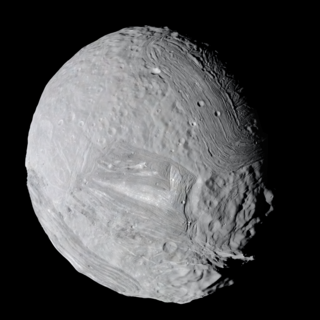
Miranda, also designated Uranus V, is the smallest and innermost of Uranus's five round satellites. It was discovered by Gerard Kuiper on 16 February 1948 at McDonald Observatory in Texas, and named after Miranda from William Shakespeare's play The Tempest. Like the other large moons of Uranus, Miranda orbits close to its planet's equatorial plane. Because Uranus orbits the Sun on its side, Miranda's orbit is nearly perpendicular to the ecliptic and shares Uranus's extreme seasonal cycle.

Umbriel is the third-largest moon of Uranus. It was discovered on October 24, 1851, by William Lassell. It was discovered at the same time as Ariel and named after a character in Alexander Pope's 1712 poem The Rape of the Lock. Umbriel consists mainly of ice with a substantial fraction of rock, and may be differentiated into a rocky core and an icy mantle. The surface is the darkest among Uranian moons, and appears to have been shaped primarily by impacts. However, the presence of canyons suggests early endogenic processes, and the moon may have undergone an early endogenically driven resurfacing event that obliterated its older surface.

Oberon, also designated Uranus IV, is the outermost and second-largest major moon of the planet Uranus. It is the second-most massive of the Uranian moons, and the tenth-most massive moon in the Solar System. Discovered by William Herschel in 1787, Oberon is named after the mythical king of the fairies who appears as a character in Shakespeare's A Midsummer Night's Dream. Its orbit lies partially outside Uranus's magnetosphere.

Titania, also designated Uranus III, is the largest of the moons of Uranus. At a diameter of 1,578 kilometres (981 mi) it is the eighth largest moon in the Solar System, with a surface area comparable to that of Australia. Discovered by William Herschel in 1787, it is named after the queen of the fairies in Shakespeare's A Midsummer Night's Dream. Its orbit lies inside Uranus's magnetosphere.

Ariel is the fourth-largest moon of Uranus. Ariel orbits and rotates in the equatorial plane of Uranus, which is almost perpendicular to the orbit of Uranus and so has an extreme seasonal cycle.

In the Slavic religious tradition, Domovoy (Russian: Домовой, literally "[the one] of the household"; also spelled Domovoi, Domovoj, and known as Polish: Domowik, Serbian: Домовик, Ukrainian: Домовик and Belarusian: Дамавік is the household spirit of a given kin. They are deified progenitors, that is to say the fountainhead ancestors of the kin. According to the Russian folklorist E. G. Kagarov, the Domovoy is a personification of the supreme Rod in the microcosm of kinship. Sometimes he has a female counterpart, Domania, the goddess of the household, though he is most often a single god. The Domovoy expresses himself as a number of other spirits of the household in its different functions.
This is a directory of lists of geological features on planets excepting Earth, moons and asteroids ordered by increasing distance from the Sun.
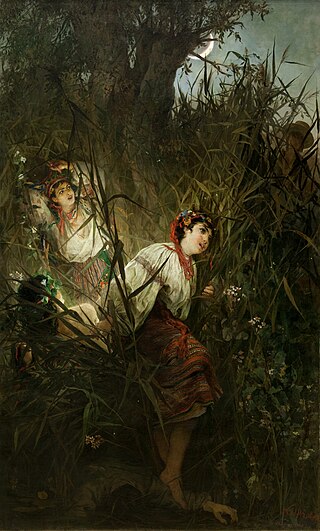
Other than the many gods and goddesses of the Slavs, the ancient Slavs believed in and revered many supernatural beings that existed in nature. These supernatural beings in Slavic religion come in various forms, and the same name of any single being can be spelled or transliterated differently according to language and transliteration system.

Uranus, the seventh planet of the Solar System, has 28 confirmed moons. Most of them are named after characters that appear in, or are mentioned in, the works of William Shakespeare and Alexander Pope. Uranus's moons are divided into three groups: thirteen inner moons, five major moons, and ten irregular moons. The inner and major moons all have prograde orbits and are cumulatively classified as regular moons. In contrast, the orbits of the irregular moons are distant, highly inclined, and mostly retrograde.

The Stones Are Hatching is a young adult fantasy novel by Geraldine McCaughrean first published in 1999 by Oxford University Press.
Ferdinand is the prince of Naples and the son of Alonso, the King of Naples, in Shakespeare's play, The Tempest. He falls in love with Miranda. He is quick to promise the title of queen and wife to Miranda even though he doesn't know her name. He is happy in humble labours, blinded by love. He makes a solemn vow to be truthful to Prospero, and not to violate Miranda's chastity before their wedding.

The Kachina Chasmata are the longest known canyon or system of canyons on the surface of the Uranian moon Ariel. The name comes from a spirit in Hopi mythology. The 622 km long and 50 km wide chasmata arise from a system of normal faults running from the north-west to south-east. The faults bound down-dropped crustal blocks forming structures called graben. The canyons cut the cratered terrain, which means that they were formed at a relatively late stage of the moon's evolution, when the interior of Ariel expanded and its ice crust cracked as a result. The floor of the canyons is not visible on the images obtained by the Voyager 2 spacecraft in January 1986; thus, whether it is covered by smooth plains like the floors of other Arielian graben is currently unknown.

Yangoor is the largest known crater on the surface of the Uranian moon Ariel. A central-peak impact crater, it is about 80 km in diameter and is located approximately 450 km from Ariel's south pole. The northwestern edge of the crater was erased by formation of ridged terrain. The crater lacks bright ejecta deposits and was imaged for the first time by the Voyager 2 spacecraft in January 1986. The crater is named after a spirit that brings day in Australian Aboriginal mythology. The name Yangoor was officially approved by the International Astronomical Union in 1988.

Folklore of Russia is folklore of Russians and other ethnic groups of Russia.
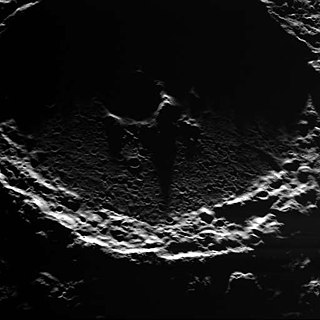
Prokofiev is a crater near the north pole of the planet Mercury, named after the Russian composer Sergei Prokofiev. Data from the MESSENGER spacecraft indicates that it contains water ice and organic compounds. Although other craters in Mercury's north polar region are also believed to contain ice, Prokofiev is the largest of them, with probable surface ice along the southern crater floor that is in perpetual darkness.
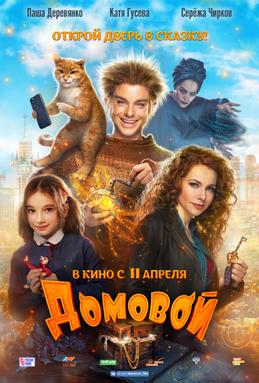
The House Elf is a 2019 Russian dark fantasy comedy film based on the Domovoy in Russian, the film was written and directed by Yevgeny Bedarev and Dmitry Bedarev in the title role. The film is a real fairy tale, it's not just the fear of a poltergeist's room, but behind the mysterious elf, and who is the head in this house. The film stars Sergey Chirkov, Yekaterina Guseva, Aleksandra Politik, Olga Ostroumova-Gutshmidt, and Pavel Derevyanko voiced the cat Kuzya.
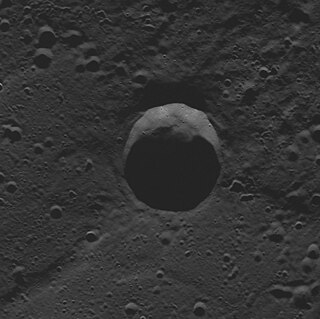
Carolan is a crater on Mercury. Its name was suggested by an Irishman, Fergal Donnelly, and two Americans, Joseph Brusseau and Deane Morrison, in a naming contest which was eventually adopted by the International Astronomical Union (IAU) on 2015. Carolan is named for the Irish composer and performer Turlough O'Carolan, who lived from 1670 to 1738 C.E. The craters Kulthum, Enheduanna, Karsh, and Rivera were also named as part of the contest.

Vonnegut is a crater on Mercury, near the north pole. It was named by the IAU in 2017 after the American author Kurt Vonnegut. Part of Vonnegut's 1959 novel The Sirens of Titan takes place on Mercury. The crater was referred to as e5 in scientific literature prior to naming.

Bunin is a crater on Mercury, located near the north pole. Its name was adopted by the International Astronomical Union (IAU) in 2019. It is named for the Russian author Ivan Bunin. The crater was referred to as l7 in scientific literature prior to naming.
















